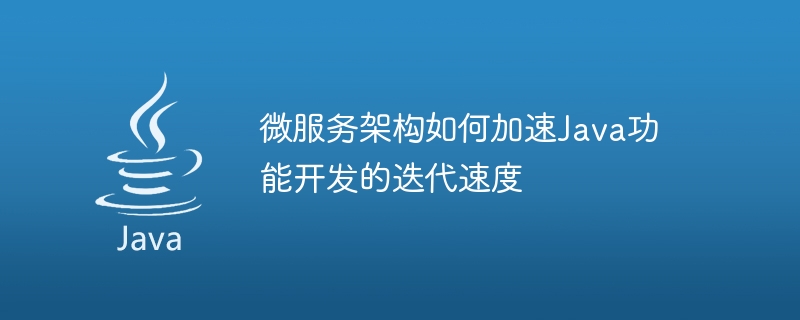Home >Java >javaTutorial >How microservice architecture accelerates the iteration speed of Java function development
How microservice architecture accelerates the iteration speed of Java function development
- PHPzOriginal
- 2023-09-18 10:12:27762browse

How microservice architecture accelerates the iteration speed of Java function development
Abstract: With the rapid development and change of the software development industry, more and more companies are beginning to adopt microservices architecture to build their applications. This article will explore how to use microservice architecture to accelerate the iteration speed of Java function development and provide specific code examples.
Introduction
With the rapid development of technologies such as cloud computing, big data and artificial intelligence, the software development industry is undergoing a new change. In this change, enterprises have increasingly higher requirements for software development speed. This requires software developers to adopt more flexible and efficient development methods to meet this demand.
Microservice architecture is becoming more and more popular as an emerging software development methodology. Its core concept is to split a large application into small, independent services, each service is responsible for completing a specific business function. This splitting method allows the development team to focus more on the development of specific functions, reducing the complexity of development and speeding up iterations.
The following will discuss how to use microservice architecture to accelerate the iteration speed of Java function development from the following aspects:
- Splitting and design of services
In a microservice architecture, splitting a large application into small, independent services is key. The advantage of this is that different functional modules can be assigned to different development teams to improve development efficiency. At the same time, each service can be deployed and upgraded independently without affecting other services, thus enabling rapid iteration.
Taking e-commerce applications as an example, we can split user management, order management, inventory management and other functions into different services. Each service has its own database, its own interface and calling method. This design allows each service to be independently developed, tested, and deployed, greatly improving development efficiency.
- Communication based on RESTful interface
In the microservice architecture, different services communicate through RESTful interfaces. This communication method is simple, flexible and easy to implement. Moreover, the RESTful interface is based on the HTTP protocol and can be well integrated with existing web development technologies.
Java developers can use the Spring Boot framework to build RESTful interfaces. Spring Boot provides developers with a concise and efficient way to build and test RESTful interfaces. The following is a simple Java code example:
@RestController
@RequestMapping("/api/users")
public class UserController {
@Autowired
private UserService userService;
@GetMapping("/")
public List<User> getAllUsers() {
return userService.getAllUsers();
}
@GetMapping("/{id}")
public User getUserById(@PathVariable("id") int id) {
return userService.getUserById(id);
}
@PostMapping("/")
public void createUser(@RequestBody User user) {
userService.createUser(user);
}
@PutMapping("/{id}")
public void updateUser(@PathVariable("id") int id, @RequestBody User user) {
userService.updateUser(id, user);
}
@DeleteMapping("/{id}")
public void deleteUser(@PathVariable("id") int id) {
userService.deleteUser(id);
}
}In this example, we define several RESTful API interfaces through annotations, which are used to add, delete, modify and check user information. Through Spring Boot's automated configuration, we can easily implement these functions.
- Container-based deployment
Microservice architecture typically uses containers to deploy and run services. Containers provide a lightweight virtualization technology that can package each service into an independent container and uniformly deploy and manage it through container management tools.
Docker is a popular container technology that can help developers quickly deploy and manage containers. We can use Docker to package each service and deploy it into different containers. In this way, each service can run independently without affecting other services.
The following is a simple Dockerfile example:
FROM openjdk:8-jdk-alpine COPY target/my-service.jar /app/my-service.jar CMD ["java", "-jar", "/app/my-service.jar"]
In this example, we use openjdk:8-jdk-alpine as the base image and copy the packaged my-service.jar file into the image and run the jar file when the container starts.
Conclusion
Using microservice architecture can accelerate the iteration speed of Java function development. Through the splitting and design of services, development efficiency can be improved; through communication based on RESTful interfaces, seamless interaction between different services can be achieved; through container-based deployment, independent deployment and operation of services can be achieved.
Of course, in practical applications, there are many other technologies and methods that can further improve development efficiency. However, as a flexible and efficient development methodology, microservice architecture is undoubtedly an important means to speed up iteration.
References:
- Spring Boot official documentation: https://spring.io/guides/gs/rest-service/
- Docker official documentation: https ://docs.docker.com/
- Martin Fowler’s blog "Microservices": https://martinfowler.com/articles/microservices.html
The above is the detailed content of How microservice architecture accelerates the iteration speed of Java function development. For more information, please follow other related articles on the PHP Chinese website!
Related articles
See more- How does html reference JavaScript? Four ways to introduce js paths in html
- What are the ways to define arrays in java
- How to get the current time in javascript
- How to handle service log collection and analysis in microservice architecture?
- Build an efficient and reliable Spring Cloud microservice architecture

